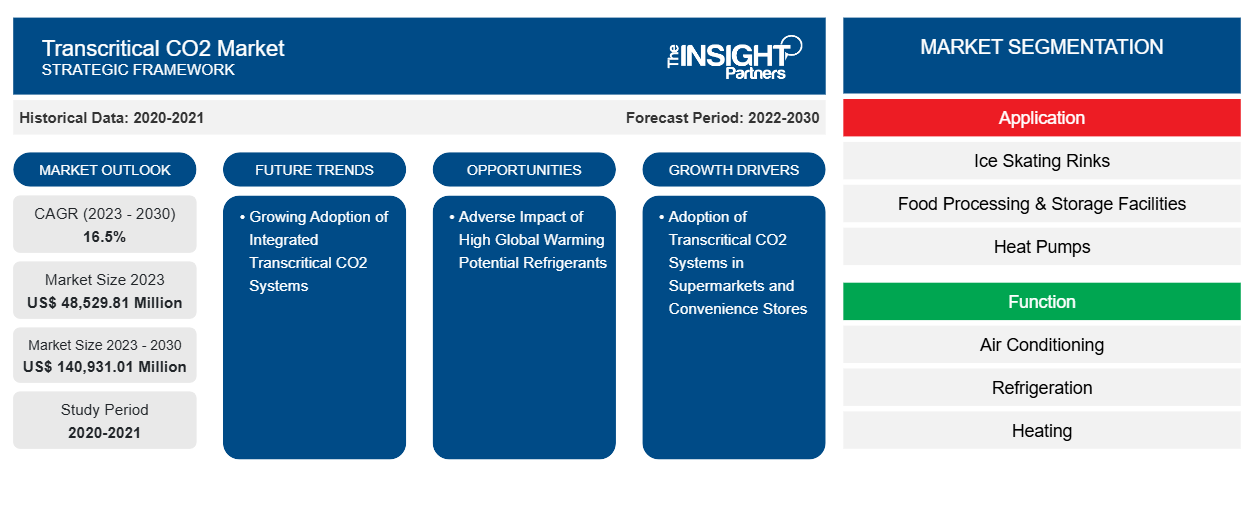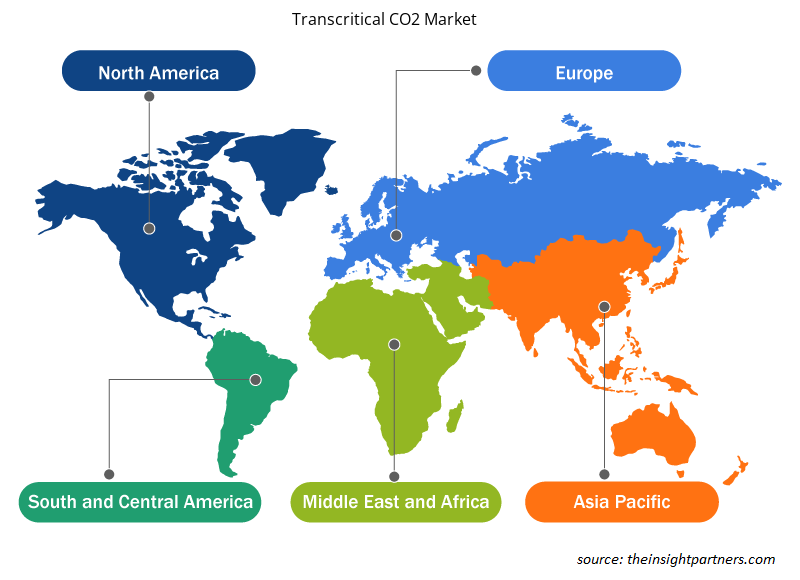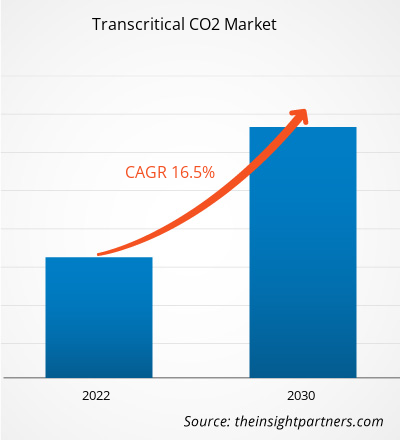Der transkritische CO2-Markt wird voraussichtlich bis 2031 ein Volumen von 156,99 Milliarden US-Dollar erreichen, ausgehend von 54,15 Milliarden US-Dollar im Jahr 2024. Für den Zeitraum 2025–2031 wird eine durchschnittliche jährliche Wachstumsrate (CAGR) von 16,8 % erwartet. Die Nutzung von aus Abfällen recyceltem CO2 in Kälteanwendungen dürfte in den kommenden Jahren neue Markttrends mit sich bringen.
Transkritische CO2-Marktanalyse
Transkritische CO2-Systeme eignen sich vor allem für Kühlhäuser, da sie eine gleichmäßige Kühlung bei geringerer Umweltbelastung bieten. Das rasante Wachstum der Kühlkettenbranche, angetrieben durch die steigende Nachfrage nach tiefgekühlten und verderblichen Lebensmitteln, ist ein wesentlicher Faktor für den steigenden Bedarf an diesen Systemen für Kühlzwecke. Innovationen bei transkritischen CO2-Systemen haben dazu beigetragen, einige der bisherigen Herausforderungen zu überwinden, beispielsweise die Ineffizienz bei hohen Umgebungstemperaturen. Entwicklungen wie die Ejektortechnologie und die Parallelkompression haben die Leistung transkritischer Systeme in wärmeren Klimazonen verbessert und ihre weltweite Anwendung vorangetrieben.
Marktübersicht für transkritisches CO2
Der transkritische CO2-Markt umfasst die Anwendung von Kohlendioxid (CO2) als Kältemittel in transkritischen Systemen. Ein transkritisches CO2-System arbeitet oberhalb des kritischen Drucks von CO2 und ist daher in Anwendungen wie Kühlung und Heizung äußerst effizient. Diese Systeme erfreuen sich aufgrund ihrer Umweltfreundlichkeit, Kosteneffizienz und Einhaltung gesetzlicher Vorschriften zunehmender Beliebtheit und unterstützen damit die Ziele, synthetische Kältemittel mit hohem Treibhauspotenzial (GWP) schrittweise abzuschaffen. Angesichts der fortschreitenden Urbanisierung in Entwicklungsregionen wie dem Asien-Pazifik-Raum, Afrika und Südamerika bietet die zunehmende Verbreitung von Supermärkten in Indien und Brasilien erhebliche Chancen für die Einführung transkritischer CO2-Systeme. Die Regierungen dieser Regionen setzen zudem Umweltrichtlinien um, die den Einsatz natürlicher Kältemittel fördern. Neben dem Einzelhandel und der Lebensmittelverarbeitung nutzen auch Branchen wie die Pharmaindustrie, die chemische Verarbeitung und Rechenzentren transkritische CO2-Systeme zur Kühlung ihrer Kühlbedürfnisse.
Sie erhalten kostenlos Anpassungen an jedem Bericht, einschließlich Teilen dieses Berichts oder einer Analyse auf Länderebene, eines Excel-Datenpakets sowie tolle Angebote und Rabatte für Start-ups und Universitäten
Transkritischer CO2-Markt: Strategische Einblicke

-
Informieren Sie sich über die wichtigsten Markttrends in diesem Bericht.Dieses KOSTENLOSE Beispiel umfasst Datenanalysen, von Markttrends bis hin zu Schätzungen und Prognosen.
Treiber und Chancen des transkritischen CO2-Marktes
Steigende Nachfrage nach energieeffizienter Klimaanlage in Rechenzentren in Nordamerika und Europa
Die wachsende Zahl von Rechenzentren kommt dem transkritischen CO2-Markt zugute. Angesichts des erheblichen Energieverbrauchs beim Betrieb von Rechenzentren müssen Konstrukteure zuverlässige, energieeffiziente Klimaanlagen für diese Einrichtungen anbieten. Europa verfügt über eine florierende Rechenzentrumsbranche mit wichtigen Knotenpunkten wie Frankfurt, London, Amsterdam, Paris und Dublin. Auch aufstrebende Märkte wie Mailand, Warschau und Berlin wachsen rasant. Mit der zunehmenden Abhängigkeit von digitalen Diensten werden Rechenzentren zum Rückgrat der digitalen Wirtschaft Europas. Durch robuste Netzwerke miteinander verbunden, ermöglichen diese Datenknotenpunkte einen nahtlosen Zugang zum Internet und unterstützen so letztendlich den Betrieb verschiedener wichtiger Sektoren wie Medizin, Biowissenschaften und Bankwesen. Rechenzentrumsbetreiber in der gesamten Region legen aufgrund der strengen EU-Vorschriften zu CO2-Emissionen zunehmend Wert auf Nachhaltigkeit. In den USA hat sich Texas aufgrund bemerkenswerter Aktivitäten der Hyperscale-Betreiber zu einem der wachsenden Rechenzentrumszentren entwickelt. Der Westen der USA positioniert sich als entwickelter Markt für Rechenzentren und beherbergt alle großen Unternehmen wie Meta (ehemals Facebook), Google und Microsoft an wichtigen Standorten wie Idaho, Oregon, Kalifornien und Utah.
Im März 2024 stellte Carrier die luftgekühlten AquaForce 30XF-Schraubenkühler mit kombiniertem hydronischem Freikühlsystem und drehzahlgeregelten Wechselrichterantrieben vor, die speziell für Rechenzentren eine Energieeffizienz von bis zu ca. 50 % erreichen sollen. Kältemittel mit HFKW werden in einigen Rechenzentrumsgeräten eingesetzt, darunter in Computerraum-Klimaanlagen (CRAC), Kühlern und einigen Reihenkühlsystemen. Mehrere Betreiber großer Rechenzentren bemühen sich, ihre Abhängigkeit von Kühlern zu verringern und sind auf Freikühlstrategien umgestiegen, die alternativ Luftaufbereitungsanlagen und Frischluft nutzen. Kältemittel werden häufig in Unternehmensrechenzentren eingesetzt, um Hyperscale- und Serviceprovider-Rechenzentren in wärmeren Klimazonen zu unterstützen, in denen Freikühlung nicht praktikabel ist. Natürliche Kältemittel in Form von CO2 finden breite Anwendung in industriellen und gewerblichen Kühlsystemen. Die steigende Nachfrage nach energieeffizienten Klima- und Kühlsystemen belebt den transkritischen CO2-Markt.
Steigende Bedeutung von CO2-Kältemitteln in der Lebensmittel- und Getränkeindustrie sowie der Pharmaindustrie
In der Lebensmittel- und Getränkeindustrie werden Kältemittel vorwiegend eingesetzt, um eine temperaturkontrollierte Umgebung zur Konservierung von Lebensmitteln und Getränken zu gewährleisten. Die Nachfrage nach verarbeiteten, konservierten und einfach zuzubereitenden Lebensmitteln steigt in den USA aufgrund der fortschreitenden Urbanisierung, des steigenden verfügbaren Einkommens und des geschäftigen Lebensstils. Ihr Geschmack und die einfache Zubereitung machen sie zudem bei jungen Menschen im Land beliebt. Konserven- oder Fertiggerichte benötigen geeignete Lagermöglichkeiten, um ihre Schmackhaftigkeit zu erhalten. Verarbeitete Lebensmittel verderben bei unsachgemäßer Lagerung sehr wahrscheinlich innerhalb weniger Tage oder Wochen. Optimale Temperatur und geeignete Lagerbedingungen sind entscheidend für die Verlängerung der Haltbarkeit von verarbeiteten oder konservierten Lebensmitteln, was den Bedarf an Kältemitteln begründet. Supermärkte und Convenience Stores haben daher in der Regel erhebliche Auswirkungen auf die Umwelt, da sie zur Lagerung verderblicher Waren auf Kühlsysteme angewiesen sind. Die zunehmende Bedeutung von Nachhaltigkeit und Umweltverantwortung unterstreicht die Notwendigkeit, den CO2-Fußabdruck und die Treibhausgasemissionen dieser Kühlsysteme zu reduzieren. Die notwendige Abkehr von Kältemitteln mit hohem Treibhauseffekt bietet daher eine Wachstumschance für Anbieter transkritischer CO2-Systeme. Da transkritische CO2-Systeme dazu beitragen, die mit herkömmlichen Kältemitteln verbundenen Umweltauswirkungen zu verringern und Nachhaltigkeitsziele zu erreichen, wird die Nachfrage nach nachhaltigen Lösungen dem transkritischen CO2-Markt auch in Zukunft zugutekommen.
Segmentierungsanalyse des transkritischen CO2-Marktberichts
Wichtige Segmente, die zur Ableitung der transkritischen CO2-Marktanalyse beigetragen haben, sind Anwendung und Funktion.
- Der Markt ist nach Anwendungsbereichen unterteilt: Eislaufbahnen, Lebensmittelverarbeitungs- und -lageranlagen, Wärmepumpen, Supermärkte und Convenience Stores. Das Segment Supermärkte und Convenience Stores dominierte den Markt im Jahr 2024.
- Nach Funktion wird der Markt in Klimatisierung, Kühlung und Heizung unterteilt. Das Segment Kühlung dominierte den Markt im Jahr 2024.
Transkritisches CO2 Marktanteilsanalyse nach Geografie
Der transkritische CO2-Markt ist in fünf Hauptregionen unterteilt: Nordamerika, Europa, Asien-Pazifik (APAC), Naher Osten und Afrika (MEA) sowie Süd- und Mittelamerika (SAM). Nordamerika dominierte den Markt im Jahr 2024, gefolgt von Europa und dem Asien-Pazifik-Raum.
Der Markt für transkritisches CO2 ist in fünf Hauptregionen segmentiert: Nordamerika, Europa, Asien-Pazifik (APAC), Naher Osten und Afrika (MEA) sowie Süd- und Mittelamerika. Im Jahr 2024 war Europa mit einem beträchtlichen Umsatzanteil Marktführer, gefolgt vom Asien-Pazifik-Raum. Darüber hinaus wird Nordamerika von 2025 bis 2031 voraussichtlich die höchste durchschnittliche jährliche Wachstumsrate (CAGR) im Markt für transkritisches CO2 verzeichnen. Der Markt für transkritisches CO2 in Europa ist in Deutschland, Frankreich, Italien, Großbritannien, Russland und das übrige Europa unterteilt. Die Region erlebte einen Anstieg der Anzahl von Kühllagern. Laut der European Cold Storage & Logistics Association (ECSLA) gibt es in Europa Tausende von Kühlhäusern mit mehr als 60.000 m3 Kühllagerkapazität für verschiedene Waren. Darüber hinaus haben die europäischen Länder Regeln und Vorschriften eingeführt, um die Emissionen fluorierter Treibhausgase und ozonschädigender Substanzen streng zu kontrollieren. Aufgrund der F-Gas-Gesetzgebung und des HFC-Ausstiegsplans ist zu erwarten, dass der Markt für transkritische CO2-Systeme in Europa in Zukunft deutlich wachsen wird.
Regionale Einblicke in den transkritischen CO2-Markt
Die Analysten von Insight Partners haben die regionalen Trends und Faktoren, die den transkritischen CO2-Markt im Prognosezeitraum beeinflussen, ausführlich erläutert. In diesem Abschnitt werden auch die Marktsegmente und die geografische Lage des transkritischen CO2-Marktes in Nordamerika, Europa, Asien-Pazifik, dem Nahen Osten und Afrika sowie Süd- und Mittelamerika erörtert.

- Erhalten Sie regionale Daten zum transkritischen CO2-Markt
Umfang des transkritischen CO2-Marktberichts
| Berichtsattribut | Details |
|---|---|
| Marktgröße im Jahr 2024 | 54,15 Milliarden US-Dollar |
| Marktgröße bis 2031 | 156,99 Milliarden US-Dollar |
| Globale CAGR (2025 – 2031) | 16,8 % |
| Historische Daten | 2021-2023 |
| Prognosezeitraum | 2025–2031 |
| Abgedeckte Segmente |
Nach Anwendung
|
| Abgedeckte Regionen und Länder |
Nordamerika
|
| Marktführer und wichtige Unternehmensprofile |
|
Marktdichte transkritischer CO2-Anlagen: Einfluss auf die Geschäftsdynamik
Der Markt für transkritisches CO2 wächst rasant. Die steigende Endverbrauchernachfrage ist auf Faktoren wie veränderte Verbraucherpräferenzen, technologische Fortschritte und ein stärkeres Bewusstsein für die Produktvorteile zurückzuführen. Mit der steigenden Nachfrage erweitern Unternehmen ihr Angebot, entwickeln Innovationen, um den Verbraucherbedürfnissen gerecht zu werden, und nutzen neue Trends, was das Marktwachstum weiter ankurbelt.
Die Marktteilnehmerdichte beschreibt die Verteilung der in einem bestimmten Markt oder einer bestimmten Branche tätigen Unternehmen. Sie gibt an, wie viele Wettbewerber (Marktteilnehmer) in einem bestimmten Marktraum im Verhältnis zu dessen Größe oder Gesamtmarktwert präsent sind.
Die wichtigsten Unternehmen, die auf dem transkritischen CO2-Markt tätig sind, sind:
- TEKO Gesellschaft für Kaltetechnik GmbH
- Baltimore Aircoil Co
- BITZER Kühlmaschinenbau GmbH
- Carrier Global Corp
- Danfoss AS
- Hussmann Corp
Haftungsausschluss : Die oben aufgeführten Unternehmen sind nicht in einer bestimmten Reihenfolge aufgeführt.

- Überblick über die wichtigsten Akteure auf dem transkritischen CO2-Markt
Neuigkeiten und aktuelle Entwicklungen zum transkritischen CO2-Markt
Der transkritische CO2-Markt wird durch die Erhebung qualitativer und quantitativer Daten aus Primär- und Sekundärforschung bewertet, die wichtige Unternehmenspublikationen, Verbandsdaten und Datenbanken einbeziehen. Einige der wichtigsten Entwicklungen auf dem Markt sind nachfolgend aufgeführt:
- CoolSys gab die Übernahme von Universal Refrigeration, Inc. bekannt. (Quelle: CoolSys, Pressemitteilung, Juni 2025)
- Evapco, ein in Maryland ansässiger OEM für natürliche Kältemittelsysteme und -komponenten, präsentierte auf der IIAR Conference and Expo vom 12. bis 15. März in Long Beach, Kalifornien, sowohl Ammoniak-Niedrigfüllsysteme (Penthouse-Kühlschränke und -Kühler) als auch transkritische CO2-Kompaktsysteme. (Quelle: Evapco, Pressemitteilung, April 2023)
- Emerson (USA) erweitert sein CO2-Kompressionsportfolio mit der Einführung des branchenweit ersten transkritischen CO2-Schraubenkompressors. (Quelle: Emerson, Pressemitteilung, März 2023)
- Hussmann, ein Unternehmen von Panasonic, erweitert sein Angebot an CO2-Kältesystemen um eine CO2-Verflüssigungseinheit (OCU) für den Außenbereich. Die OCU ist für Mittel- und Tieftemperaturanwendungen konzipiert und bietet Vielseitigkeit und Effizienz für die Einzelhandelskühlung. (Quelle: Hussmann, Pressemitteilung, Dezember 2024)
Marktbericht zu transkritischem CO2 – Abdeckung und Ergebnisse
Der Bericht „Transcritical CO2 Market Size and Forecast (2025–2031)“ bietet eine detaillierte Analyse des Marktes, die die unten genannten Bereiche abdeckt:
- Marktgröße und Prognose für transkritisches CO2 auf globaler, regionaler und Länderebene für alle wichtigen Marktsegmente, die im Rahmen des Berichts abgedeckt sind
- Markttrends für transkritisches CO2 sowie Marktdynamiken wie Treiber, Einschränkungen und wichtige Chancen
- Detaillierte PEST- und SWOT-Analyse
- Marktanalyse für transkritisches CO2 mit wichtigen Markttrends, globalen und regionalen Rahmenbedingungen, wichtigen Akteuren, Vorschriften und aktuellen Marktentwicklungen
- Branchenlandschaft und Wettbewerbsanalyse mit Marktkonzentration, Heatmap-Analyse, prominenten Akteuren und aktuellen Entwicklungen für den transkritischen CO2-Markt
- Detaillierte Firmenprofile
- Historische Analyse (2 Jahre), Basisjahr, Prognose (7 Jahre) mit CAGR
- PEST- und SWOT-Analyse
- Marktgröße Wert/Volumen – Global, Regional, Land
- Branchen- und Wettbewerbslandschaft
- Excel-Datensatz
Aktuelle Berichte
Verwandte Berichte
Erfahrungsberichte
Grund zum Kauf
- Fundierte Entscheidungsfindung
- Marktdynamik verstehen
- Wettbewerbsanalyse
- Kundeneinblicke
- Marktprognosen
- Risikominimierung
- Strategische Planung
- Investitionsbegründung
- Identifizierung neuer Märkte
- Verbesserung von Marketingstrategien
- Steigerung der Betriebseffizienz
- Anpassung an regulatorische Trends






















 Kostenlose Probe anfordern für - Transkritischer CO2-Markt
Kostenlose Probe anfordern für - Transkritischer CO2-Markt